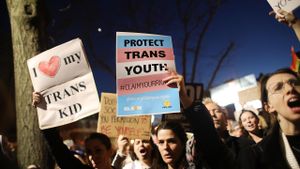The United States is moving forward with plans to house up to 30,000 migrants awaiting deportation at the Guantanamo Bay naval base, as announced by President Donald Trump on February 1, 2025. This initiative marks a significant ramp-up in immigration enforcement strategies, following directives issued to the Defense Department and the Department of Homeland Security to prepare the facility for this unprecedented number of individuals.
During the announcement, President Trump stated, "We have 30,000 beds in Guantánamo to detain the worst criminal illegal aliens threatening the American people." This evocative statement highlights the administration's view on the necessity to manage what they describe as dangerous individuals who cannot be reliably held by their home countries.
The use of Guantanamo Bay, often associated with high-security detentions, raises complex questions about legal rights and due process for those housed there. Karen Greenberg, director of the Center on National Security at Fordham University School of Law, remarked, "It is not correct to call it on foreign soil. It is on a U.S. base located in Guantanamo Bay," emphasizing the unique legal position of the facility.
Trump's order not only signifies the commitment to expand the capacity for detaining migrants but also reflects broader concerns about border security and the effectiveness of international cooperation on immigration. Many believe the plan aims to circumvent potential limitations imposed by foreign nations on repatriation, as articulated by both Trump and Homeland Security Secretary Kristi Noem, who asserted, "This will double our capacity immediately, right? And tough. That’s a tough, tough place to get out of." Noem added during appearances on media outlets like Fox News, stressing the facility's readiness to house these individuals, corroborated by Trump's assertion about the facility's capabilities.
Nevertheless, experts voice substantial concern about the practical implementation of such plans. Guantanamo Bay has hosted various populations of migrants over the years, and records from previous admissions are marred with reports detailing unsanitary conditions and insufficient legal oversight. Greenberg pointed out, "Reports are not good," referencing historical accounts and recent findings from the International Refugee Assistance Project, which underscored the troubling conditions experienced by migrants currently detained there.
A significant challenge identified by administrative experts is the sheer number of migrants anticipated. Greenberg questioned whether the facility could realistically accommodate 30,000 new arrivals based on past figures, noting, "At the height... they held 21,000 at the most. They’ve held refugees repeatedly, but not at the scale being suggested now." This skepticism around capacity raises important logistical challenges, including the construction of additional facilities and support services for not only the migrants but also the necessary staff required to manage them.
Critics have also arisen from constitutional law perspectives, with voices like Vince Warren, executive director of the Center for Constitutional Rights, stating, "Guantanamo really should be known as the dumping ground for American executive action," emphasizing the lack of transparency surrounding operations there and the historical allegations of human rights violations, including torture techniques. Warren pointed out the decreased scrutiny due to its military status, arguing, "There’s no transparency. There’s no information about what happens there." This alarming characterization reflects deep-rooted concerns about the potential legal repercussions of detaining migrants under such conditions.
Looking to the future, the Department of Homeland Security is preparing to initiate the movement of migrants to Guantanamo Bay, with hopes of commencing this within 30 days. Tom Homan, House border czar, indicated plans for fast-tracked construction of the facility, yet acknowledged logistical limitations, mentioning, "Hopefully within 30 days we’ll start moving people there." Nevertheless, it seems likely they will begin with much smaller numbers compared to the maximum capacity proposed, as Homan hinted at the necessity to assess conditions and residence appropriateness steadily.
Utilizing such facilities for this purpose raises questions not only about immigration policy but also about the moral and ethical responsibilities the U.S. bears toward those individuals who may find themselves held under its jurisdiction. The situation at Guantanamo Bay serves as a focal point for discussions about national security, human rights, and the integrity of the American judicial system.



